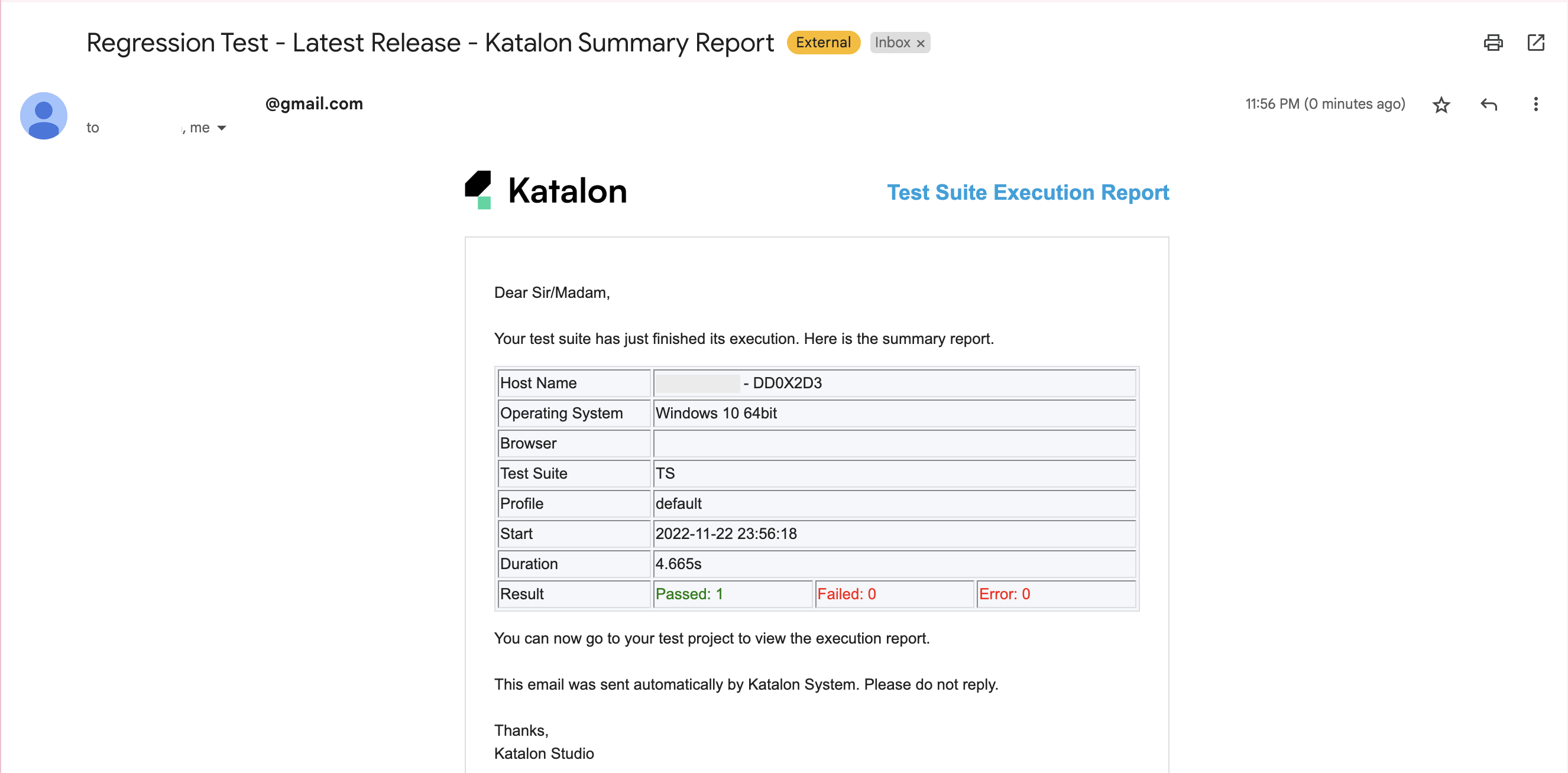Share test reports via email in Katalon Studio
An active Katalon Studio Enterprise license.
After a test suite or test suite collection execution, you might want to automatically send summary reports to your own email or other stakeholders to notify them about the test result. This document shows you how to set up your mail server and customize email reports to automatically send out a summary report email whenever a test execution finishes.
Starting from 10.4.0, AI Failure Analysis is included in email test reports. It provides instant, plain-language explanations for test failures. Learn how to enable and use this time-saving feature here: StudioAssist AI Failure Analysis.
Email settings
In Katalon Studio, go to Project > Settings > Email to configure email server settings. You can also customize the email template and choose which types of report files to be sent as attachments, for example, HTML, CSV, PDF, Log, or PNG.

By default, after you successfully set up your mail server, sender, and recipients, Katalon Studio sends all email reports for test suite executions, including test suites inside a test suite collection.
As an exclusive feature for Katalon Studio Enterprise, you have an option to keep your mailbox tidy by only sending email reports for test suite collection executions and skipping all emails for test suites stored inside that test suite collection. This option is useful when executing test suite collections containing many test suites.

Mail server settings
Mail Server Settings define the mail server Katalon Studio uses for sending emails. To set up your mail server, you need to fill in your mail server host, port, credentials, and choose a protocol option.
Host and Port:
- Host: The domain name of the mail server.
- Port: The port to be used for that server.
Below is a list of some common outgoing mail (SMTP) server configurations:
| Email sever | Host | Port | Reference |
|---|---|---|---|
| Gmail | smtp.gmail.com | 465 or 587 | Check Gmail through other email platforms |
| Outlook | smtp.office365.com | 587 or 25 | How to set up a multifunction device or application to send email using Microsoft 365 or Office 365 |
| Yahoo! Mail | smtp.mail.yahoo.com | 465 | POP access settings and instructions for Yahoo Mail |
Username and Password:
- Username: Your full email account to authenticate with the server (e.g., yourusername@gmail.com)
- Password: Your email password to authenticate with the server. This could be a password generated from App Passwords.
For Gmail users:
- If your email accounts are using two-step authentication, you can use Google App Passwords to set up a Gmail account in Katalon Studio. An App Password is a 16-digit passcode that gives Katalon Studio permission to access your Google Account. In the Select app dropdown of App Passwords, select the option Other (Custom name) to generate an app password for Katalon Studio. Then, use the generated passwords to put in the password section of Mail Server Settings. For details, see Google Account Help documentation: Sign in with App Passwords.
- If you do not use two-step authentication, you can allow less secure apps to access your account. However, to help keep your account secure, starting May 30, 2022, Google will no longer support the use of third-party apps or devices which ask you to sign in to your Google Account using only your username and password. For detail, see Google Account Help documentation: Less secure apps & your Google Account.
For Yahoo! Mail, make sure to allow less secure apps to access your account. Follow this guide: Ways to securely access Yahoo Mail.
As some SMTP servers do not require authentication and username in email address format, Katalon Studio does not validate usernames and passwords.
Protocol: The protocol to communicate with the mail server. There are three options:
- None
- SSL (Secure Sockets Layer)
- TLS (Transport Layer Security)
Encrypt authentication data: For sensitive data protection, we recommend enabling Encrypt authentication data.
After you fill in your mail server information, you can send a test email to check if the mail server is set up correctly. Input an email in the Recipients field, then click Send Test Email. The Send test email button is only enabled once Mail Server Settings and Recipients are filled correctly.

Email template
You can define the sender, recipients (the list of emails to receive reports), email subject, and body template in this section.

Katalon Studio supports adding Test Suite and Test Suite Collection names in your email subject with the placeholders ${suiteName} and ${suiteCollectionName}, respectively.
Report format
- Ensure the Project > Settings > Plugins > Report > PDF option is explicitly enabled. Without this, a PDF report will not be attached to the email.
- For an HTML report, when you enable the Attach reference images using linked screenshots (not embedded) to reduce report file size option in Project > Settings > Plugins > Report, only screenshots saved in the
Reportsfolder are included in the report. If you want to save screenshots outside theReportsfolder, do not select this option to avoid missing screenshots in your email report.
Body template
Customize email template for test suite
To customize the email body template used for a Test Suite, do one of the following:
-
Go to Project > Settings > Email > Template, then select Test Suite from the dropdown.
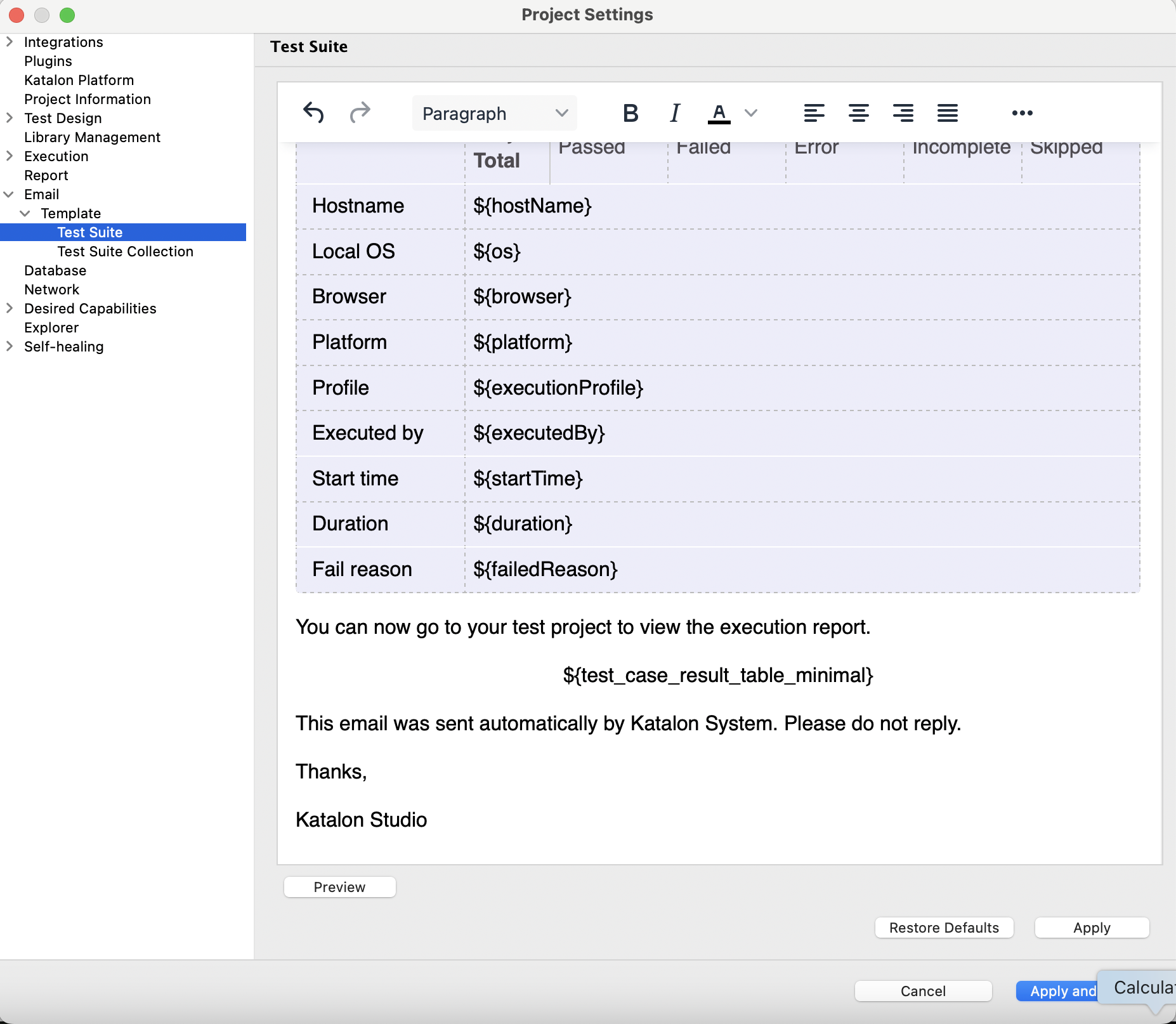
-
Or click Edit Template for Test Suite Execution from the Email Settings screen.
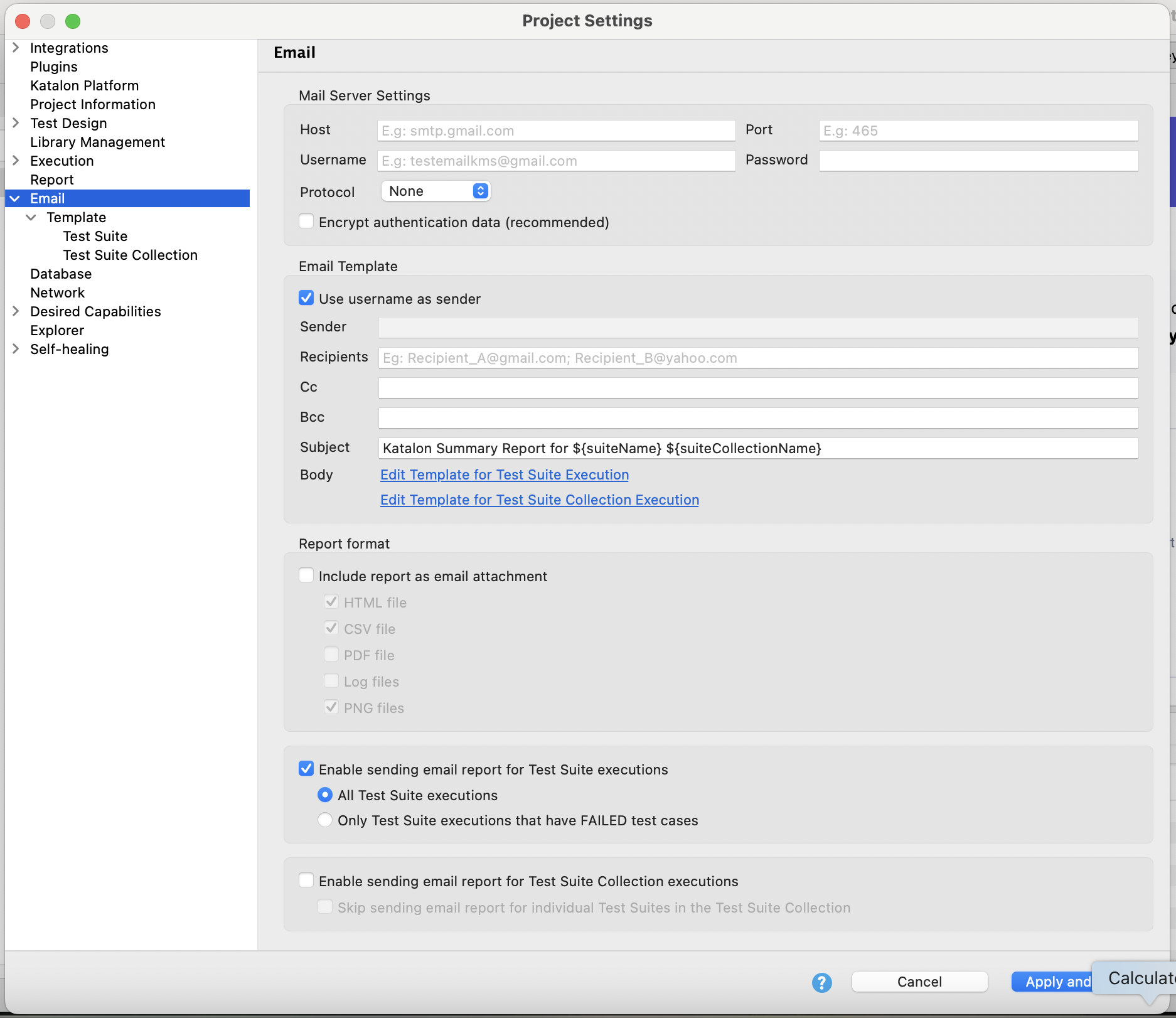
The Test Suite email report template is displayed and is editable. Use the main navigation bar above the template, or click within the email body to reveal the quick edit menu.
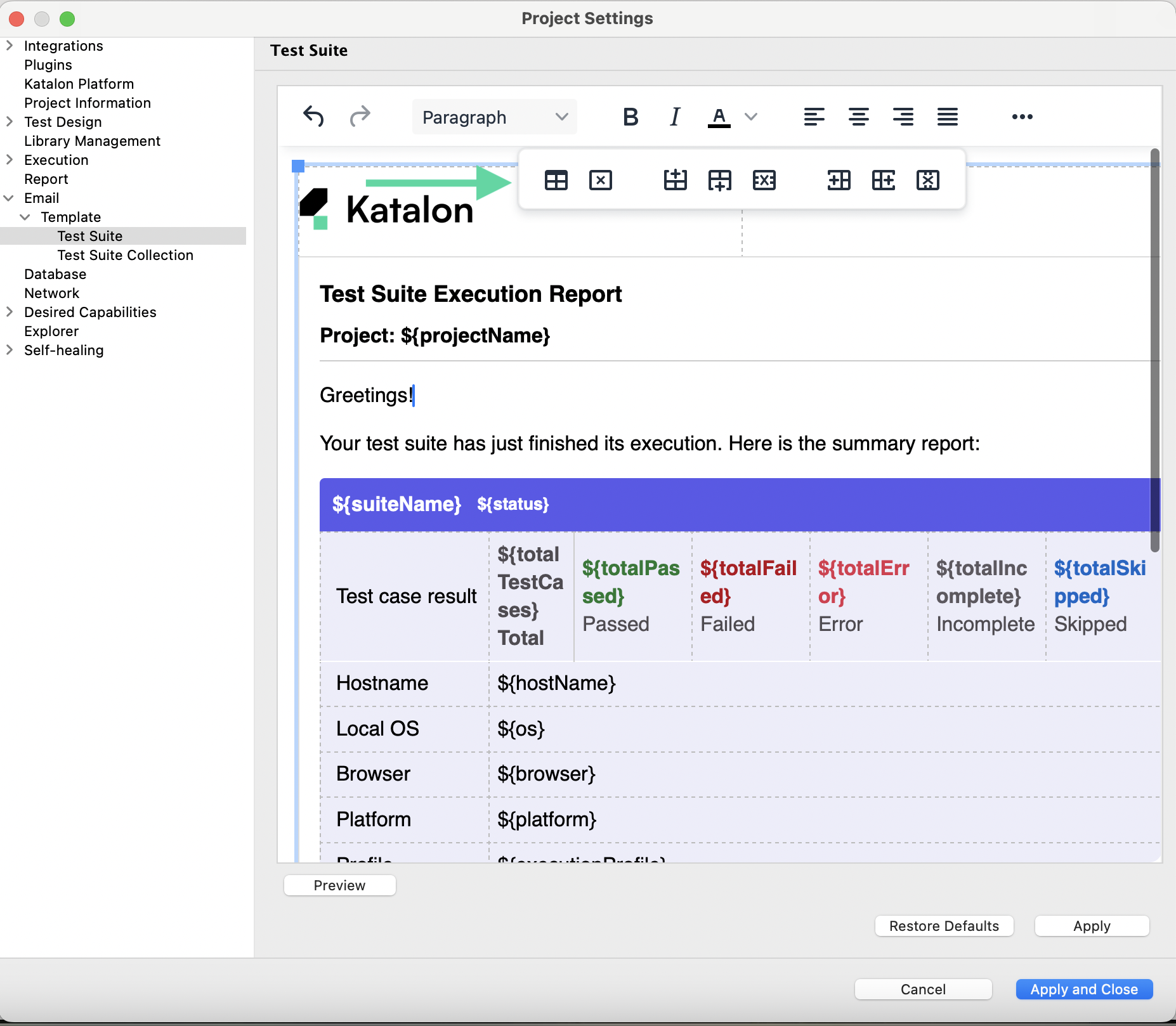
Use the following supported variables to customize the content of the Test Suite email template:
| Variable | Description |
|---|---|
${hostName} | Name of the host machine where the test was executed. |
${os} | Operating system used during test execution. |
${browser} | Browser name and version used (for Web tests). |
${deviceId} | ID of the device used for test execution. |
${deviceName} | Name of the device used for test execution. |
${suiteName} | Name of the test suite executed. |
${executionProfile} | Execution profile used during the test run. |
${startTime} | Timestamp indicating when the test execution started. |
${duration} | Total duration of the test execution. |
${totalPassed} | Number of test cases that passed. |
${totalFailed} | Number of test cases that failed. |
${totalError} | Number of test cases that encountered errors. |
${totalIncomplete} | Number of test cases that did not complete. |
${totalSkipped} | Number of test cases that were skipped. |
${executedBy} | Username or identity that initiated the test execution. |
${projectName} | Name of the Katalon Studio project. |
${failedReason} | Describes the failure reason if the test suite did not pass. |
${status} | Overall status of the test suite (e.g., Passed, Failed). |
For projects created in Katalon Studio version 10.1.0 or later, you can include a test case result table in the email body.
To display a test case result table in your email report, manually insert one of the following variables into your Test Suite email template where you want the table to appear:
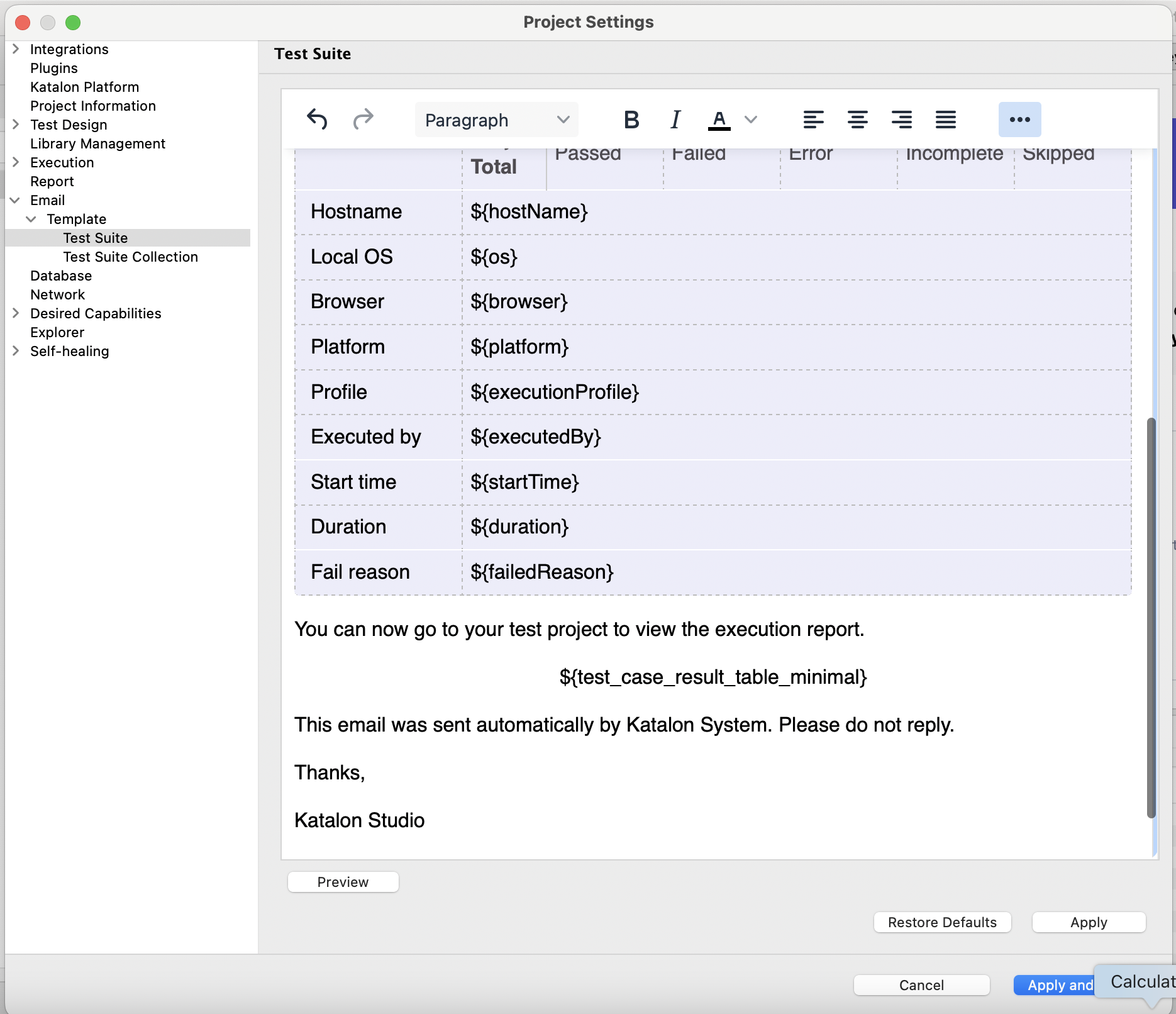
Refer to the table below to choose the appropriate variable for your reporting needs:
| Variable | Description | When to Use |
|---|---|---|
${test_case_result_table} | Displays the test case ID and status for all test cases. | Use for comprehensive reports intended for debugging, QA reviews, or audit documentation. |
${test_case_result_table_minimal} | Introduced in Katalon Studio 10.3.0, this displays only the test case ID and status for failed and error test cases. | Use for lightweight reports such as CI/CD notifications, stakeholder summaries, or quick overviews. |
The ${test_case_result_table} variable is only supported in the Test Suite email template. If used in a Test Suite Collection template, the email will fail to send.
Before saving your changes, click Preview to see how the Test Suite Execution report will appear in the email.
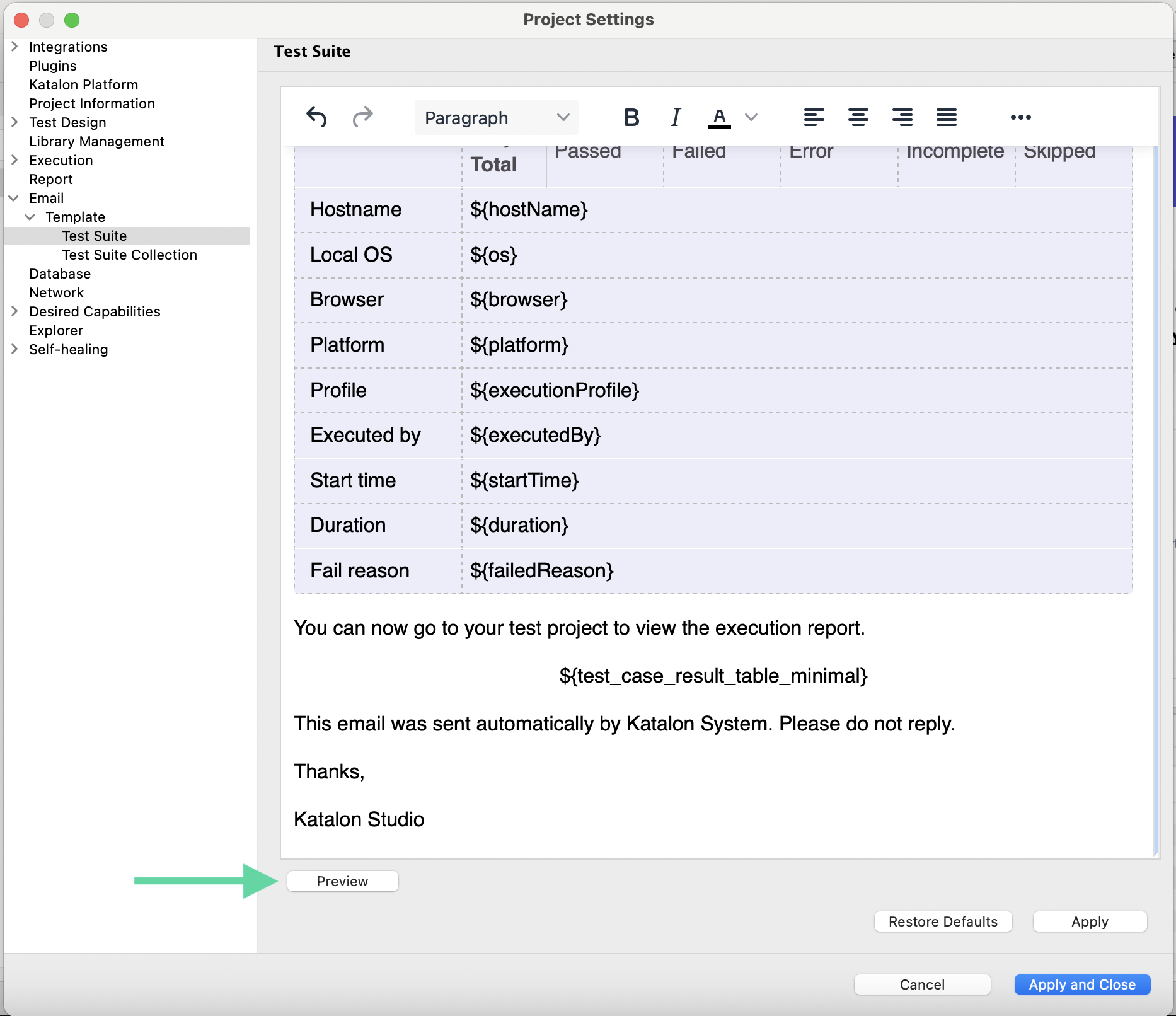
Below is a sample report of a successful test suite execution as received via email:
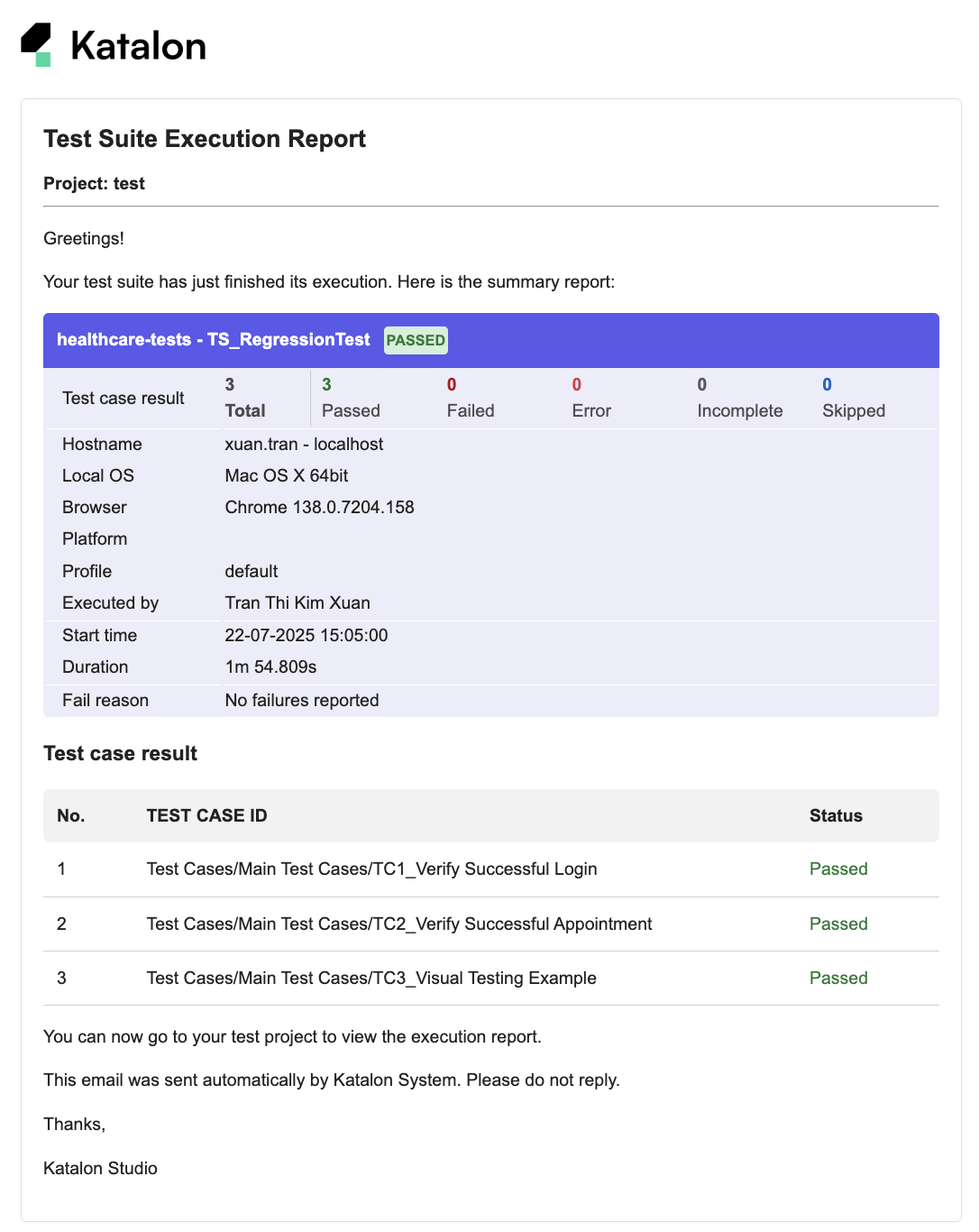
Below is a sample report of a failed test suite execution as received via email:
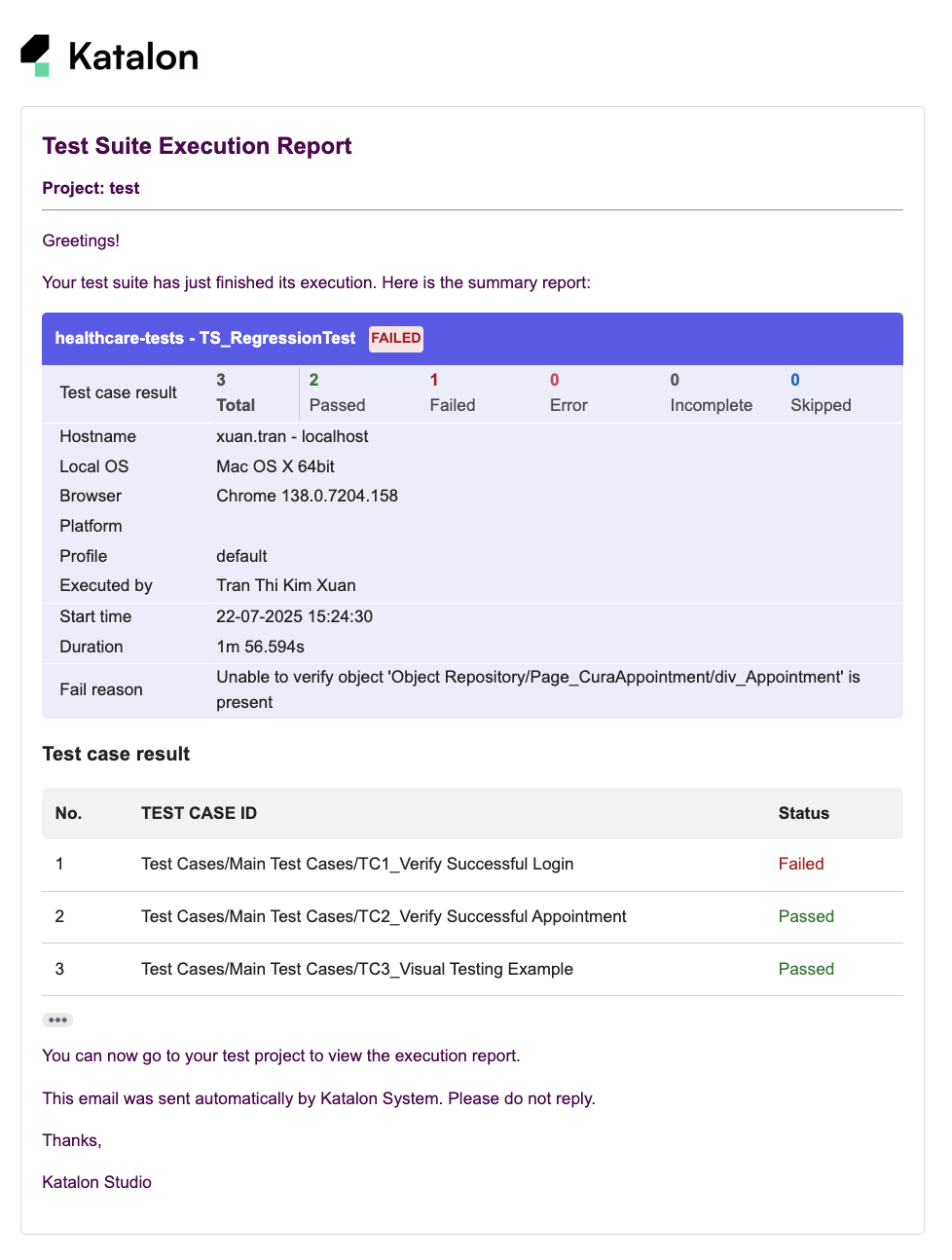
Click Apply or Apply and Close when you have finished your customization.
Customize email template for test suite collection
To customize the email body template used for a Test Suite Collection, do one of the following:
-
Go to Project > Settings > Email > Template, then select Test Suite Collection from the dropdown.
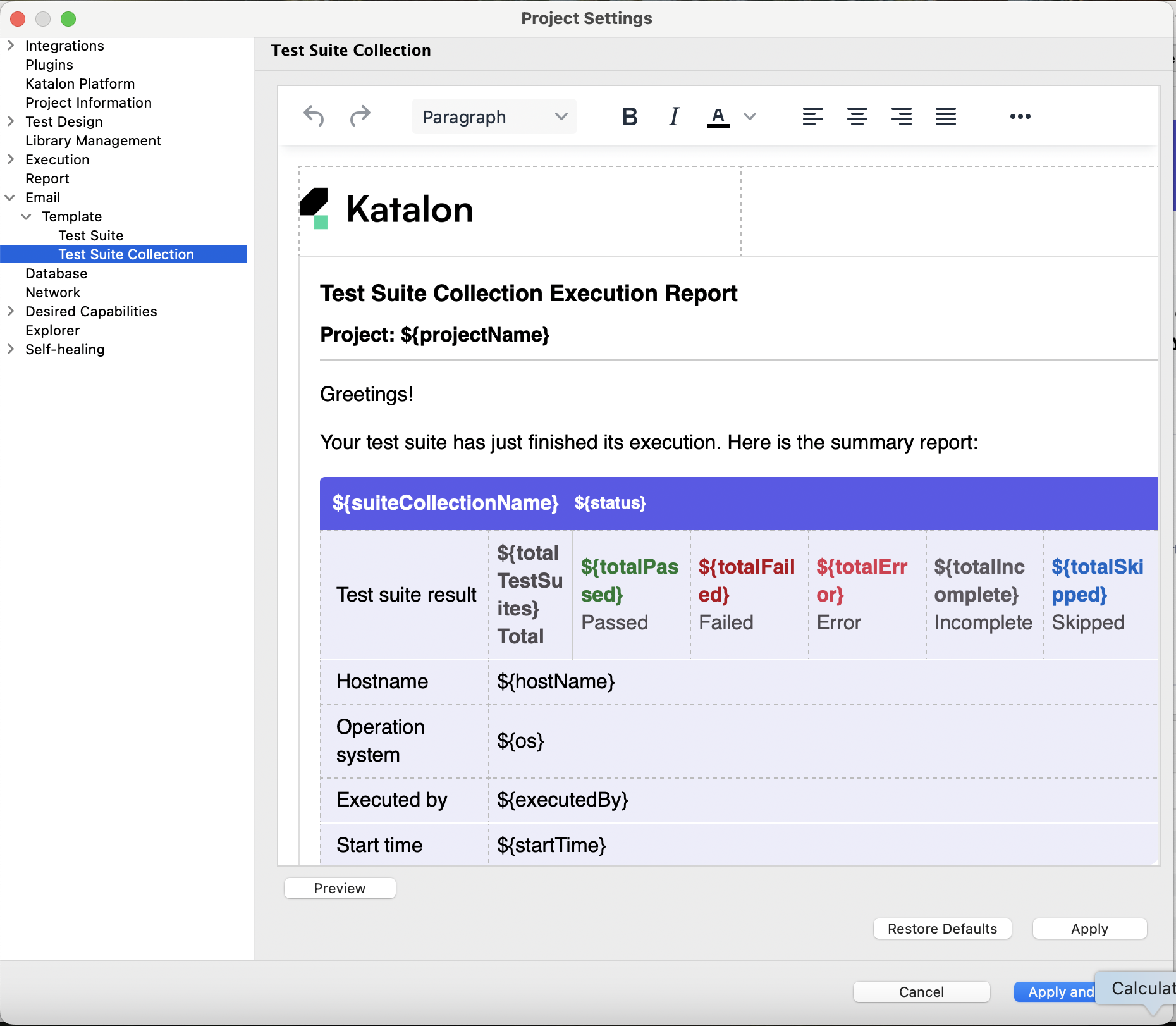
-
Or click Edit Template for Test Suite Collection Execution from the Email Settings screen.

Use the following variables to customize the content of the Test Suite Collection email template:
| Variable | Description |
|---|---|
hostName | Host's name |
os | Operating system |
suiteCollectionName | Name of the Test Suite Collection |
startTime | When the Test Suite Collection started running |
duration | Duration of the test execution |
totalPassed | Total passed test suites |
totalFailed | Total failed test suites |
totalError | Total error test suites |
totalIncomplete | Total incomplete test suites |
totalSkipped | Total skipped test suites |
${tsc_case_result_table} | Displays the test case ID and status for all test suites in the test suite collection. |
${tsc_case_result_table_minimal} | Displays only the test case ID and status for failed or error test cases in the test suite collection. |
${test_suite_result_table} | Displays the test suite ID and status for all test suites in the test suite collection. |
From version 10.3.0 onward, the Test Suite Collection email template counts results based on the Test Suite instead of the Test Case.
Before saving your changes, click Preview to see how the Test Suite Collection Execution report will appear in the email.
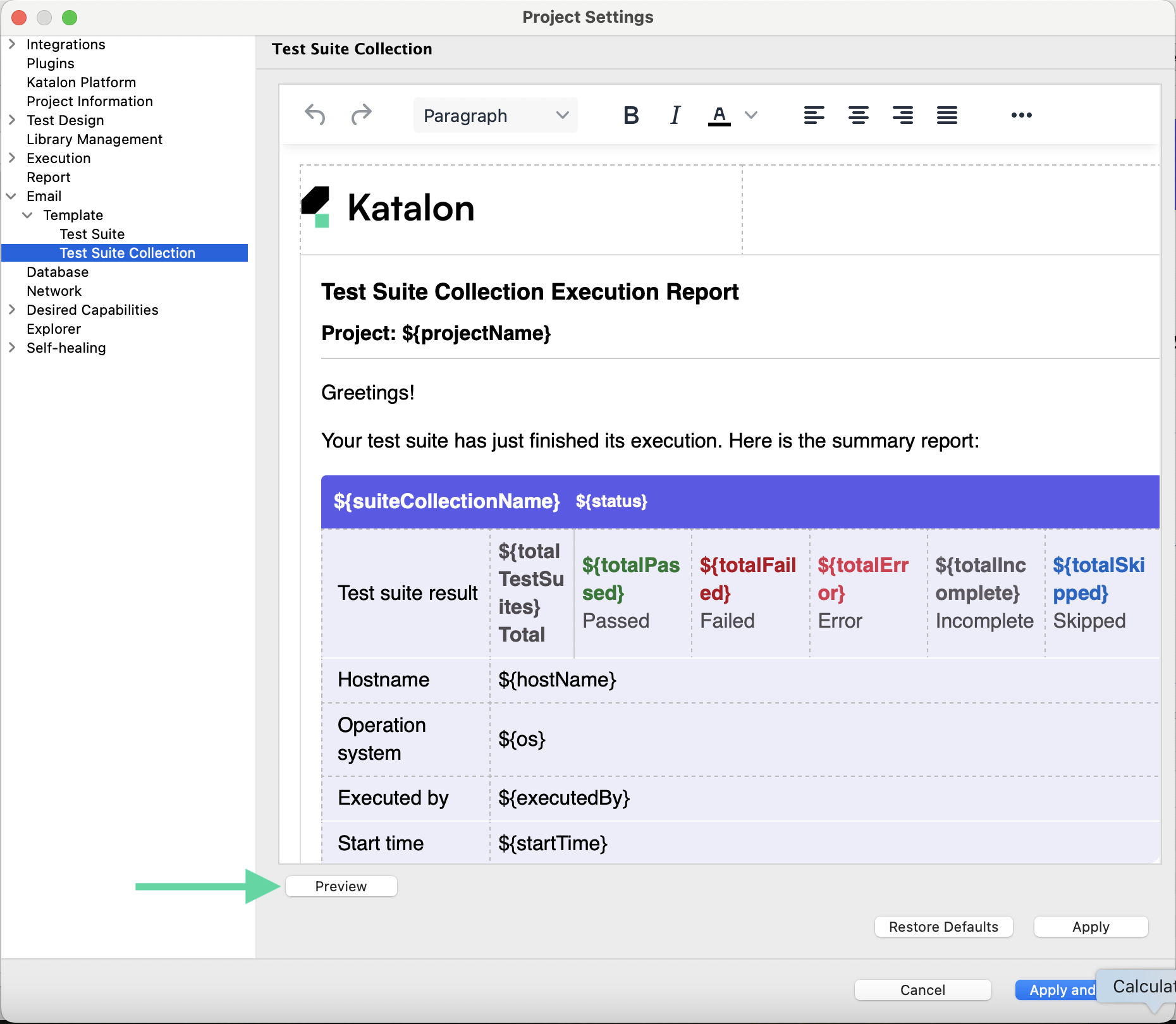
Below is a sample Test Suite Execution report as received via email:
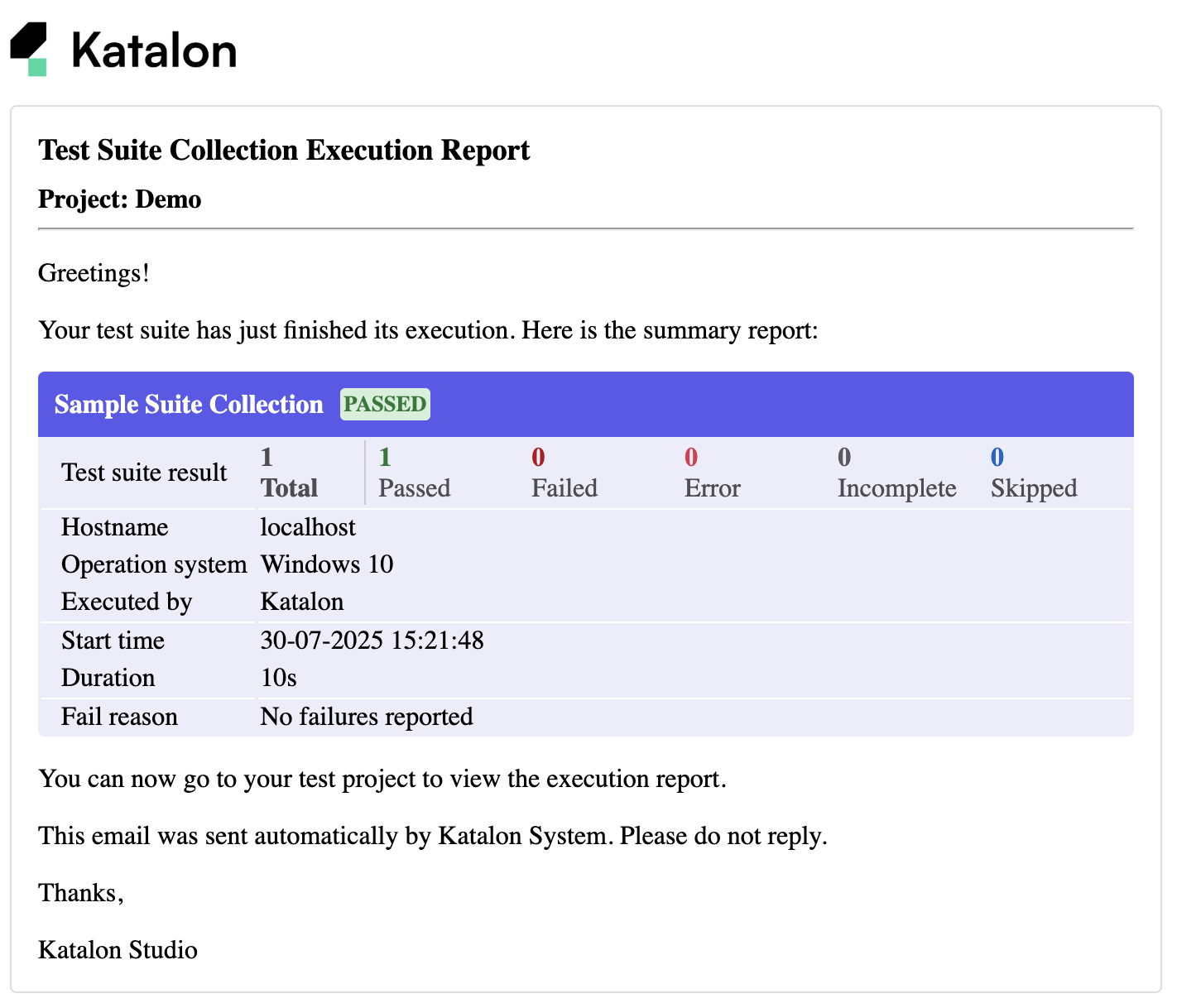
Click Apply or Apply and Close when you have finished your customization.
Use global variables for emails
Scope of application:
- When sending email reports on a Test Suite, the global variables in the selected execution profile are applied.
- When sending email reports on a Test Suite Collection:
- For a Test Suite Collection: only the global variables in the default profile are applied.
- For Test Suites contained in a Test Suite Collection: the global variables in the selected execution profile of each Test Suite are applied.
The below section guides you on how to do that with a usage example.
